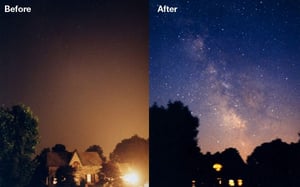Remember those days when sky-gazing was a favorite pastime activity for children? Something about the dark sky – its vastness, remoteness and grandeur – enchants our minds and calms our spirits.
Today, the sky above us sure looks different. The increased and widespread use of artificial light – from street lights, to house lighting, to city signage and advertising – has hidden our view of the sky.
What Happened in the Last Hundred Years?
One hundred years ago, you could walk outside your door and have a clear view of the starry sky above you.
Today, according to a study conducted by Science Advances, 99 percent of the public in the United States and Europe can’t experience a natural night unaffected by light pollution.
This finding draws serious concerns about light pollution. Excessive artificial outdoor light not only affects our views, but has environmental impact on people, wildlife and the climate. Just take a look at the before and after of the 2003 Northeast blackout – a massive power outage that had the side effect of showcasing what a natural dark sky truly looks like.

Before and during the 2003 Northeast blackout, a massive power outage affecting 55 million people.
Credit: International Dark-Sky Association
Bringing Stars Back to the Night Sky
So how do we address this challenge? As connected technology becomes more prevalent, the solution is not necessarily about reducing technology in cities, but rethinking how urban lighting is conducted. In fact, as cities continue to become smarter, the need to deliver timely information to citizens while actively working to reduce companies’ carbon footprint has never been greater.
Paving the way is the City of Pittsburg, which has made considerable strides in balancing environmental concerns and the aesthetic of the urban city.
In 2021, it became the first major city to pass a dark-sky ordinance in alignment with International Dark-Sky Association’s (IDA) values of sustainability and green living.
Being a light pollution hotspot, it will be interesting to see the positive changes that will take place in Pittsburg in the years to come.

Astronauts aboard the International Space Station took this “before shot” on Aug. 1, 2021, to register the light pollution levels in Pittsburgh. Even from far out in space, the city lights were easily recognizable.
Credit: NASA
E Ink’s Commitment to Sustainability
At E Ink, sustainability has always been a core component of our business. In fact, we are the first display technology to be certified through the IDA.

Credit: E Ink
As a reflective technology, our displays contribute less light pollution and use less energy. Due to the unique attributes of digital paper, E Ink’s displays do not emit any light, using ambient lighting around them to be viewed. When incorporated into smart city signage or outdoor displays, digital paper offers an organic viewing experience without introducing bright light that disrupts the neighborhood or the environment.
Sustainability is no longer a buzzword that will fade away in time, and the health of our people and our environment comes first. Building a smart city is a collaborative effort, and we all have a part to play to ensure that the future is connected, shared, and sustainable.
What can each of us do? Check out IDA’s helpful tips that can help us get started. Let’s bring back the starry night sky for more generations to enjoy!


Leave Comment